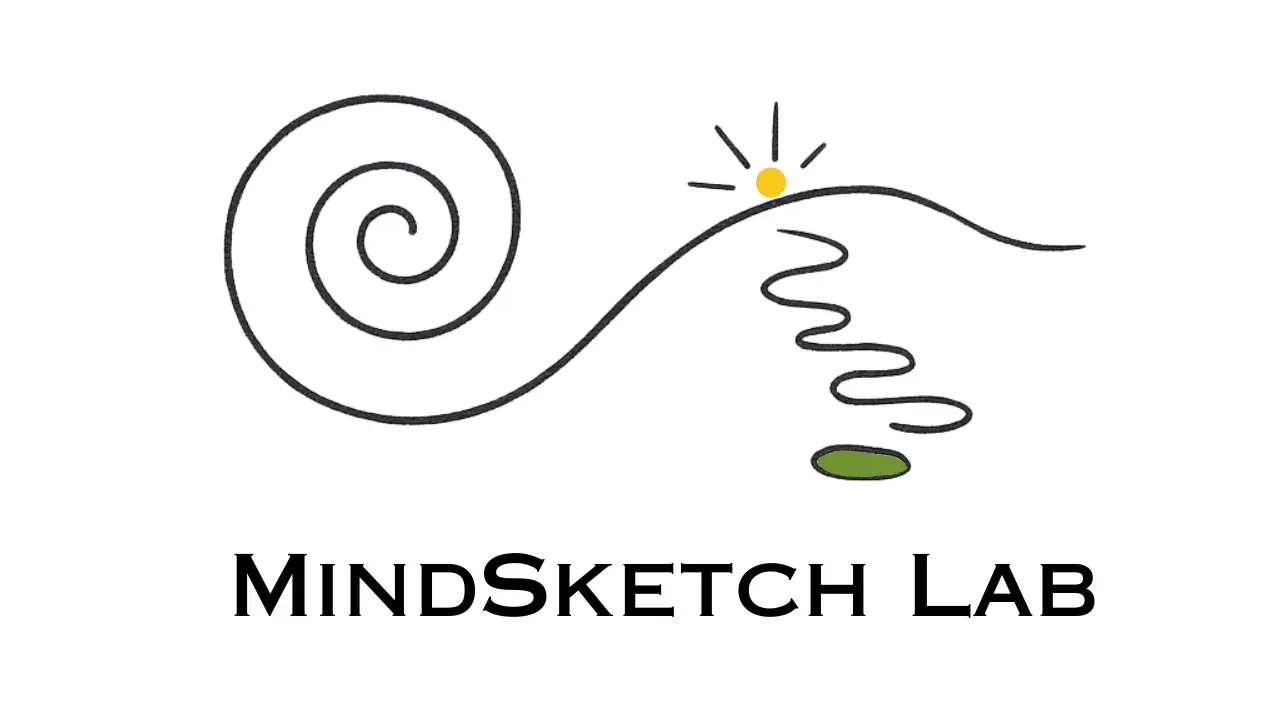Beyond Brainstorming: Neurographic Visioning for Strategic Clarity and Real Impact
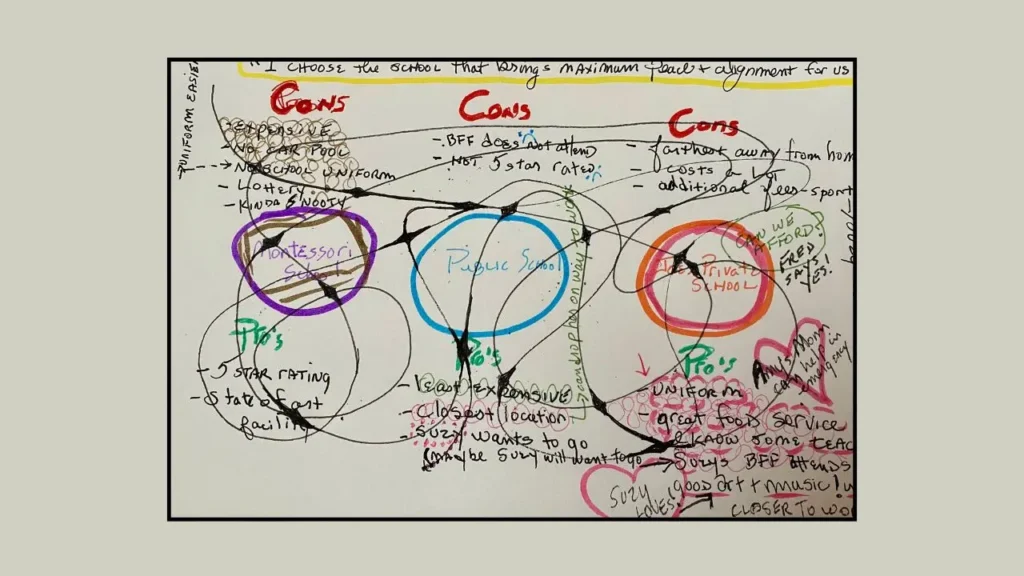
Stuck replaying the same thoughts, second-guessing yourself, and still not deciding? You are not alone. When pros and cons lists stall, try Neurographic Art for Decision Making, a simple visual method that quiets mental noise so choices feel obvious.
Neurographic Art is a simple drawing method that rounds sharp corners into smooth nodes to calm mental noise and reveal next steps. Try it for 10–20 minutes with paper and pen.
Clarity and tension can’t coexist. Neurographic Art is a visual thinking process that uses free-flowing lines, color, and shape to calm the nervous system, relieve stress, and turn messy decisions into clear direction and focused action.
This post shows a practical way to break patterns of old thinking, especially when the old ways no longer work.
Hold the pen lightly, go with the flow, and give yourself permission to pause. Stopping and returning often helps your mind digest new ideas. A short, step-by-step method is below.
What Is Neurographic Art and Why It Helps With Decisions
Neurographic Art is a healing art form that offers stress relief through simple drawing, soothing a busy and distracted mind.
You draw slow, curved lines that cross, then focus on rounding corners so the shape feels smooth. Your eyes read those curves as safe, which eases friction and dev elops new neural pathways.
If you think this is woo-woo – I get it. I was skeptical too at first. Then I did a deep dive and learned neurographic art is backed by scientists. The, more importantly I tried visual thinking using neurographic art- and haven’t stopped!
The late neurosurgeon, scientist, and teacher Dr Jim Doty Focus on neuroplasticity and how the brain can be “rewired” through focused intention and specific mental statesWith less noise, attention shifts from rumination to noticing, and connections you could not see begin to form.
When you keep circling the same old debate in your head, a standard pros and cons list can trap you in mental loops. This visual thinking process interrupts the loop. It gives your brain a new path to follow.
This does not require art skill. Paper, a pen, 10 to 20 minutes, and a mind open to try new processes are enough. If you want a deeper dive later, see MindSketch Lab’s guide on Neurographic Art for Faster Decision-Making.
A clear, simple definition you can use today
Think of Neurographic art as a visual thinking process with curves. Draw free, flowing lines that cross and connect, then round off every sharp corner.
You are mapping thoughts and feelings so the mind can settle. No need to draw well. Tools are basic: paper, pen or marker, 10 to 20 minutes. Hold the pen lightly and go with the flow.
Why it works when old ways no longer work

Find Your Focus Type
Pick the focus type that fits your current mental mess — no judgment. Just awareness. Are you the:
- Overthinker
- Multitasker
- Reactor
- Perfectionist
- Scroller
Novel, fluid movement plus rounding corners can signal safety, based on psychological principles. That helps calm nervous system and frees attention for insight.
Overthinking keeps replaying the same track, but curves invite new tracks while promoting neural connections. Try it for choosing a class, a job change, weekend plans, or the next best project to finish, especially to overcome creative blocks.
When To Use Neurographic Art and Visual Thinking
Use it when you feel scattered, stuck, or second-guessing. Good fits not know what to prioritize, making a tough high stakes decision including career change, relationships, or buying a big ticket item – like education or housing.
Try 10 to 15 minutes on a short break, or 20 to 30 minutes when emotions run high.
Myths That Keep People From Trying Neurographic Art and Visual Thinking
- It is only for artists. False. It is a thinking tool.
- It is mysterious or woo. It is structured drawing with clear steps.
- It guarantees the perfect answer. It supports clarity so you hear your own mind better.
Try It Now! A 10–20 Minute Neurographic Art Exercise
This simple 7-step method helps you quiet mental noise, calm the nervous system, and make decisions with more clarity. All you need is paper, a pen, and 10–20 minutes of relaxed focus.
Step-by-Step: 7 Steps to Make a Clear Decision with Neurographic Art
Time: 10–20 minutes | Tools: Paper, pen or marker, optional colors, timer
1️⃣ Set Your Intention (1 minute)
Write a clear question or intention at the top of your page — something specific and open-ended.
Example: “Which school brings the most peace for our family?”
This anchors your drawing session to one clear decision.
2️⃣ Prepare Your Space (1 minute)
Gather simple supplies: paper, pen or marker, and optional colors.
Silence notifications, take three slow breaths, and relax your shoulders.
3️⃣ Draw Free-Flowing Lines (1–2 minutes)
Place your pen on the paper and draw slow, curving lines that cross and connect.
Let your hand move naturally — no erasing, no judging.
These are your neurographic lines.
There are no mistakes.
4️⃣ Round the Corners (3–5 minutes)
Each time lines intersect or form sharp angles, round those corners into smooth nodes.
These rounded shapes signal safety to your brain, easing mental tension.
5️⃣ Add Meaning and Color (3–5 minutes)
Label two or three options in different zones or shapes of the drawing.
Add color that feels right for each option.
Where space feels tight, write a word like “worry” or “ease.”
You’re not decorating — you’re mapping emotion and clarity.
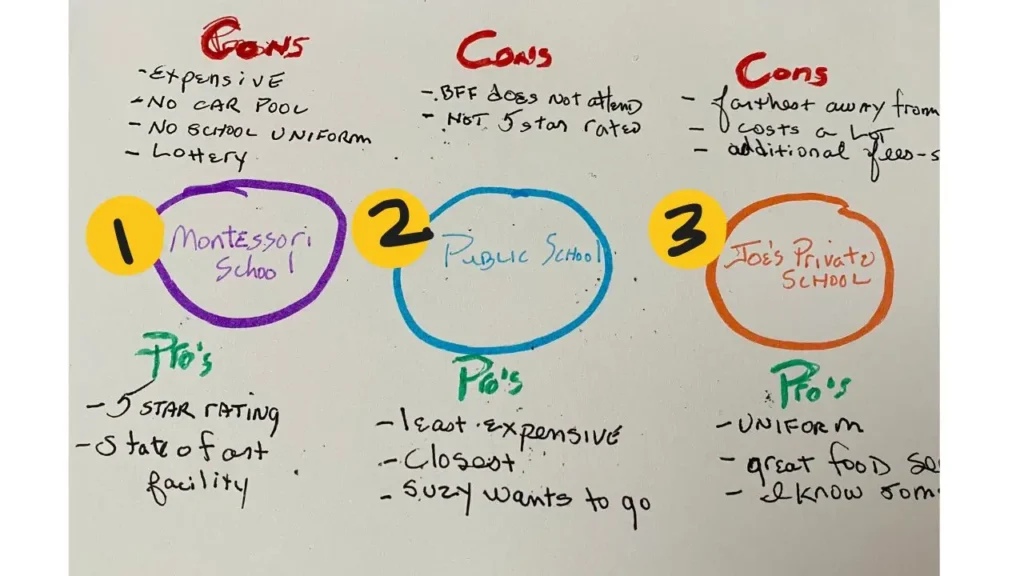
6️⃣ Pause and Return (as needed)
Step away for 10 minutes or a full day.
When you come back, notice what feels smoother or heavier.
Add a few more lines or colors, rounding new corners as ideas settle.
7️⃣ Read the Map and Choose One Small Step (5 minutes)
Look for the area that feels most open or calm — that’s your signal.
Capture your insight in one sentence, then take a tiny action within 24 hours
(e.g., send an email, schedule a call, or make a short list).
This decision pretty much jumped off the page and danced for all to see.

Action Steps: Turn Insights Into Action Without Overthinking
The drawing is a map. Use it to choose a small, low-risk next step, then learn by doing. For more mental decluttering support, see Neurographic Art for Mental Decluttering.
Read the map: what is your drawing telling you?
- Which option visually catches your eye first?
- Where did you add the most bright, happy colors or lines?
- Which area feels tight or heavy?
- What one word sums up each option now?
Capture the top two signals in one sentence.
Make a low-risk test you can do in 24 hours
Do you have weekend plans conflicts? Try this visual thinking method. Make it fun!
Track what you learn, then adjust
Do a 5-minute debrief. What worked, what felt off, what surprised you?
If the choice is clear commit to it as part of your decision making, if not plan the next tiny test.
If you still feel stuck
Ask a trusted friend if you are asking the right questions, or talk to a coach or counselor for deeper patterns.
Stuckness often means old thinking patterns are shifting.
Try the exercise, then walk away if you feel stuck. Come back with fresh eyes and repeat as needed. Act as if you are the most confident person in the room.
A quick real-life example
This quick real-life example shows Neurographic Art in action for everyday decisions. Choosing a school for “Susie” started with three shapes represented as circles for options.
Notes grew as the lines flowed: uniforms make mornings easier, sports fees do not matter because Susie prefers art and music, a friend’s mom nearby could help in a pinch.
Costs and distance were weighed next to ratings and facilities. After rounding corners and adding a few more lines, the choice stood out. The final check, “Can we afford it?” got a yes, so the decision landed with peace.
While this was a simple choice, the depth of insight achieved, even concerning minor worries, is why the method is also utilized in more profound emotional work like trauma processing.
Why I say this method works. I have no children and know little about school systems. By sitting still and thinking about what each pen stroke and word meant my brain was prompted to ask the next question.
I was amazed I could come up with logical reasoning for this important decision many must have to make.
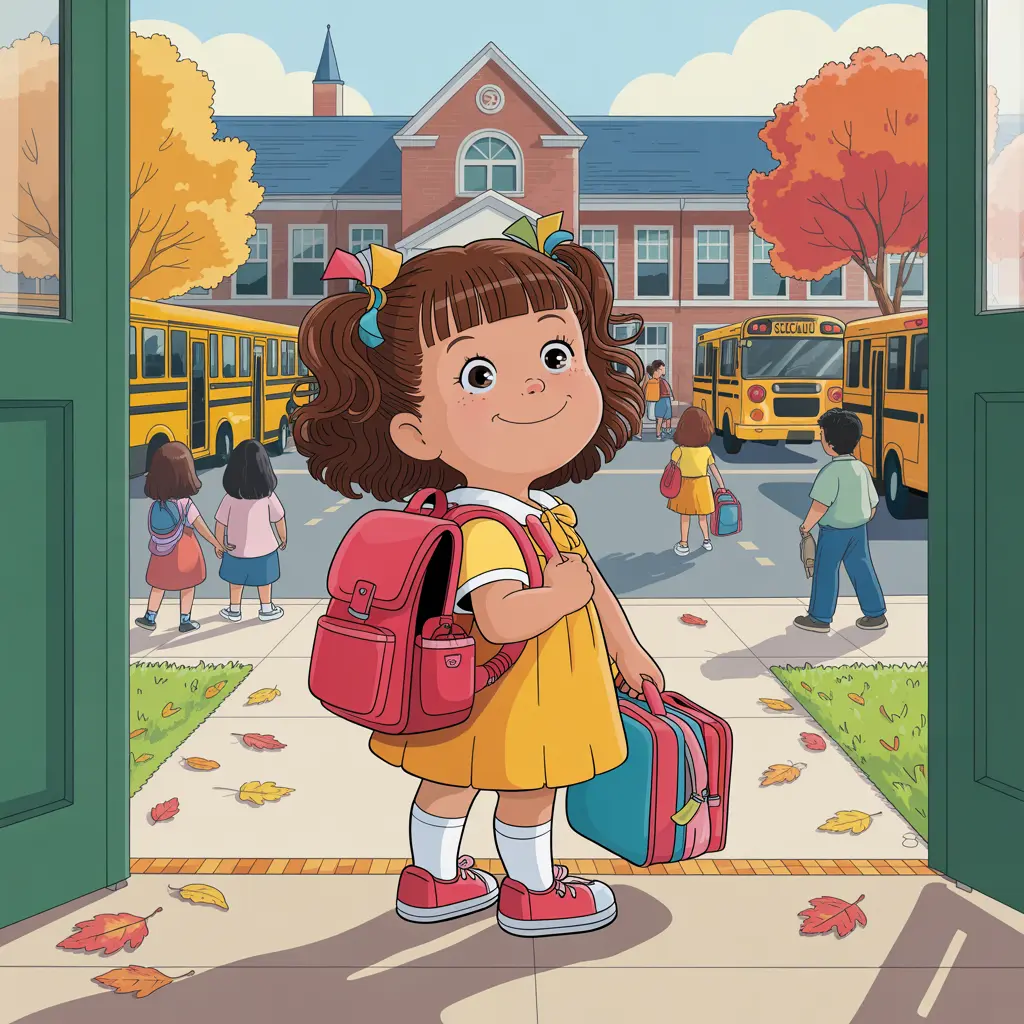
⚖️ Limitations and When Not to Use It
- Not a substitute for therapy or medical advice.
- If drawing triggers frustration or anxiety, pause and try guided breathing or journaling instead.
- Some choices need practical data (costs, deadlines, logistics) — use this method alongside those tools.
- Overuse can turn it into another “loop.” Stop after 20 minutes and revisit later for fresh perspective.
- If you’re experiencing persistent stress or emotional overwhelm, seek a licensed counselor or coach.
Who This Is and Is Not For
✅ Best For:
- Overthinkers replaying the same choices.
- Creatives and visual learners who process through drawing.
- Coaches, teachers, or parents teaching calm decision-making.
- Anyone who wants a nonverbal way to sort thoughts and find clarity.
🚫 Not Ideal For:
- Readers expecting guaranteed or quick-fix answers.
- People needing medical or psychological treatment.
- Those who dislike open-ended exercises or prefer structured data analysis.
- Anyone without a quiet moment or space to draw (try written prompts instead).
FAQ: Neurographic Art for Decision Making
1. Do I need artistic skill?
No. This is not art for display — it’s a thinking tool. Focus on flowing lines and rounding corners, not how it looks.
2. How long should a session take?
About 10–20 minutes. Shorter if you’re just exploring; longer if you’re working through big emotions or choices.
3. What supplies do I need?
Plain paper, any pen or marker, optional colors, and a timer.
4. Can I use this for serious life decisions?
Yes, but pair it with logic tools (pros/cons, research, or professional advice). It’s for clarity and calm, not final judgment.
5. Is this art therapy?
No. It’s a self-reflection and decision-making technique, not a clinical treatment.
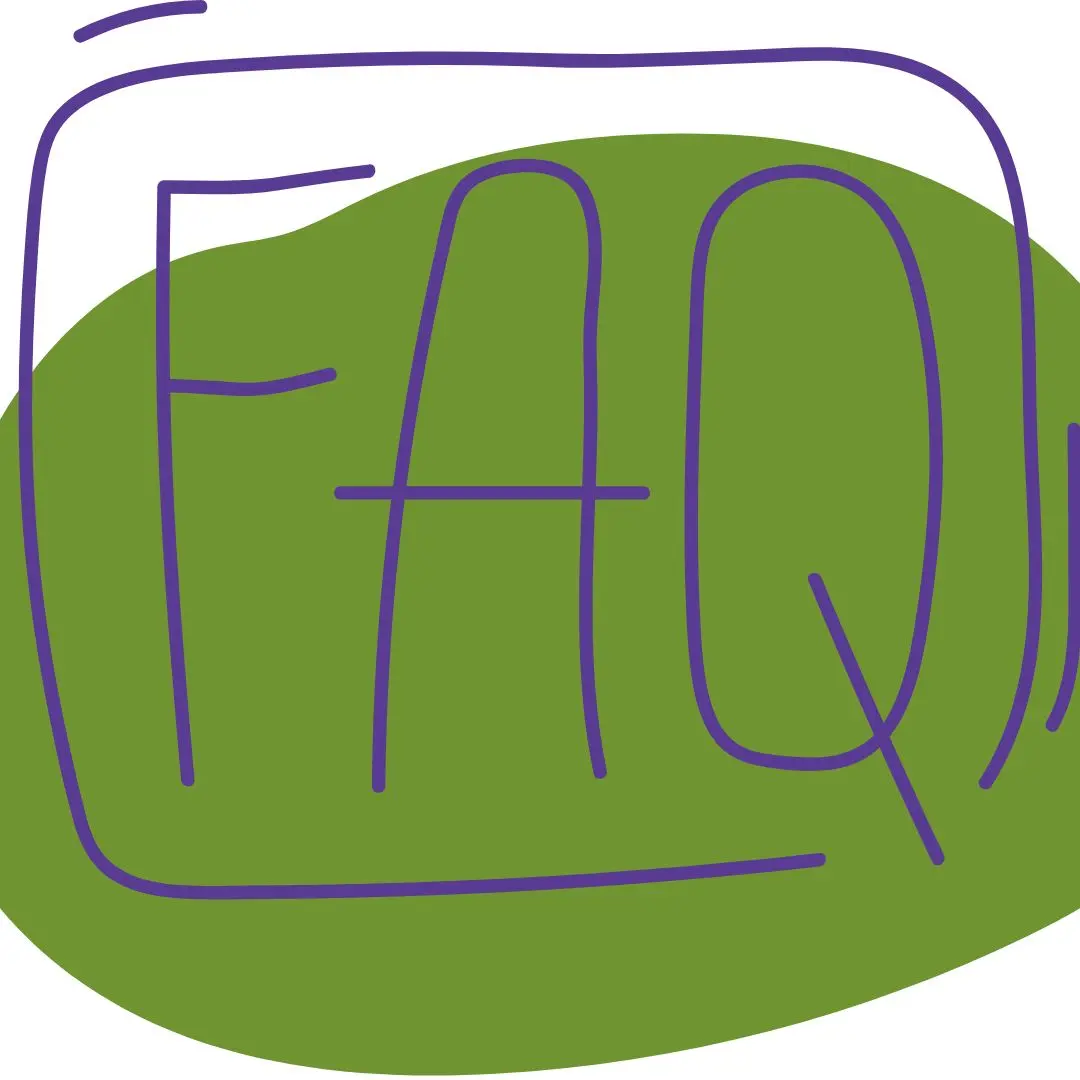
When old ways stall, you don’t have to stay stuck. Neurographic Art gives your mind a fresh path. Hold the pen lightly, go with the flow, and remember it is okay to stop and return so ideas can settle.
Start with one decision, try a 10-minute Neurographic Art drawing today, then take one small next step for faster decisions. If you want help or want to share your outcome, send a note to hello@mindsketchlab.com.

Marj Bates has spent years practicing and helping people clear both mental and physical clutter. A lifelong artist and peace-seeker, she weaves together neurographic art, The Artist’s Way, other time-tested practices, and her own story into one gentle space: The MindSketch Lab.
“Marj’s now shares her methods through The MindSketch Lab, helping others quiet mental noise and rediscover focus through creative practice.”
Bring your stuckness, your unsettled mind, and a sketch pad.
Learn to quiet the noise, soften the fear, and release what’s holding you back.
No art skills required—promise.
Art journal your way to clarity with us in our safe and private community, MindSketch Lab on Facebook
